Enhancing Communication and Academic Skills in Health and Social Care
VerifiedAdded on 2023/06/07
|12
|3729
|418
AI Summary
This article discusses the communication process, key features of types of communication, barriers affecting communication, and ways to overcome them. It also highlights the importance of ICT and academic skills in healthcare. The subject is Health and Social Care, and the course code is not mentioned. The article is relevant to students and professionals in the healthcare sector. Desklib provides access to solved assignments, essays, and dissertations on this topic.
Contribute Materials
Your contribution can guide someone’s learning journey. Share your
documents today.
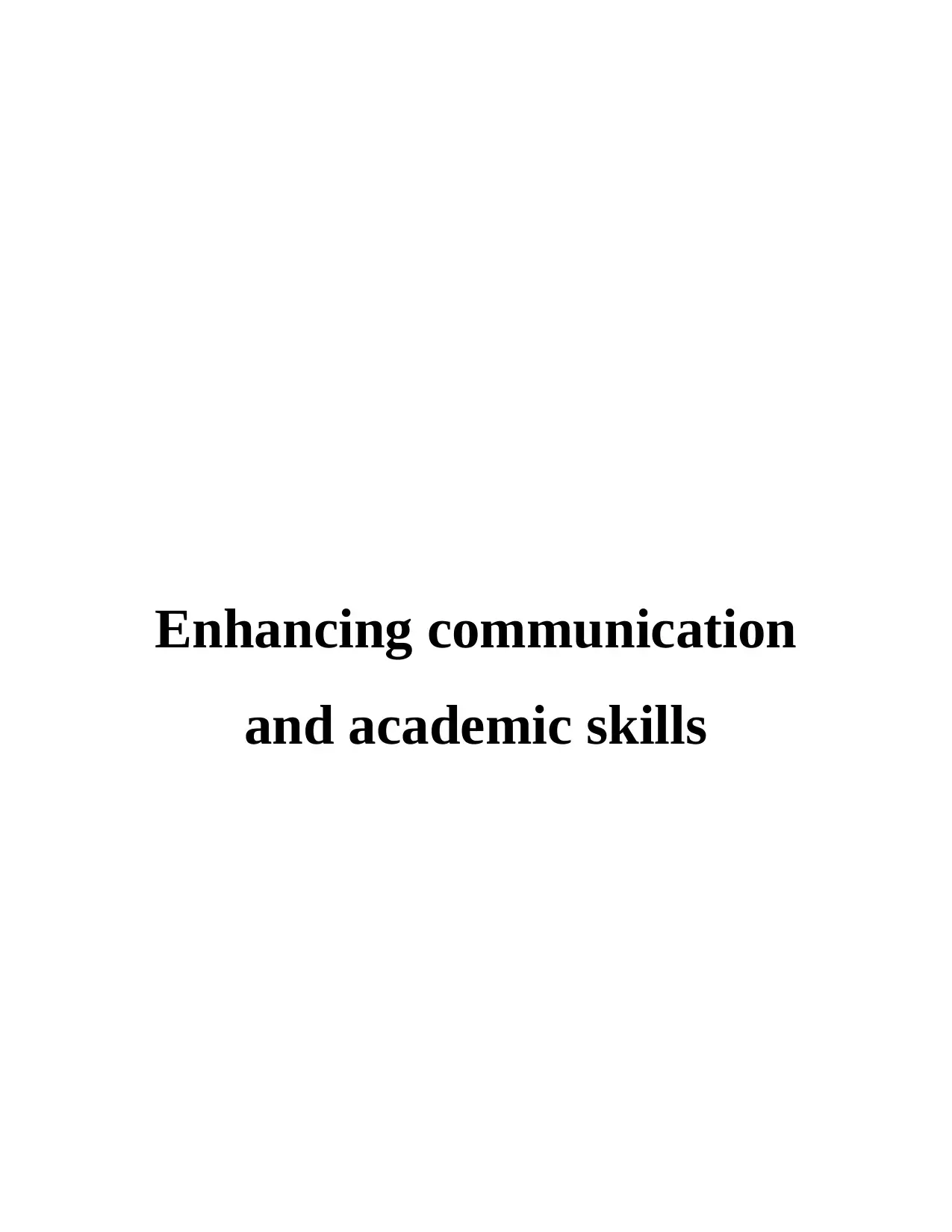
Enhancing communication
and academic skills
and academic skills
Secure Best Marks with AI Grader
Need help grading? Try our AI Grader for instant feedback on your assignments.
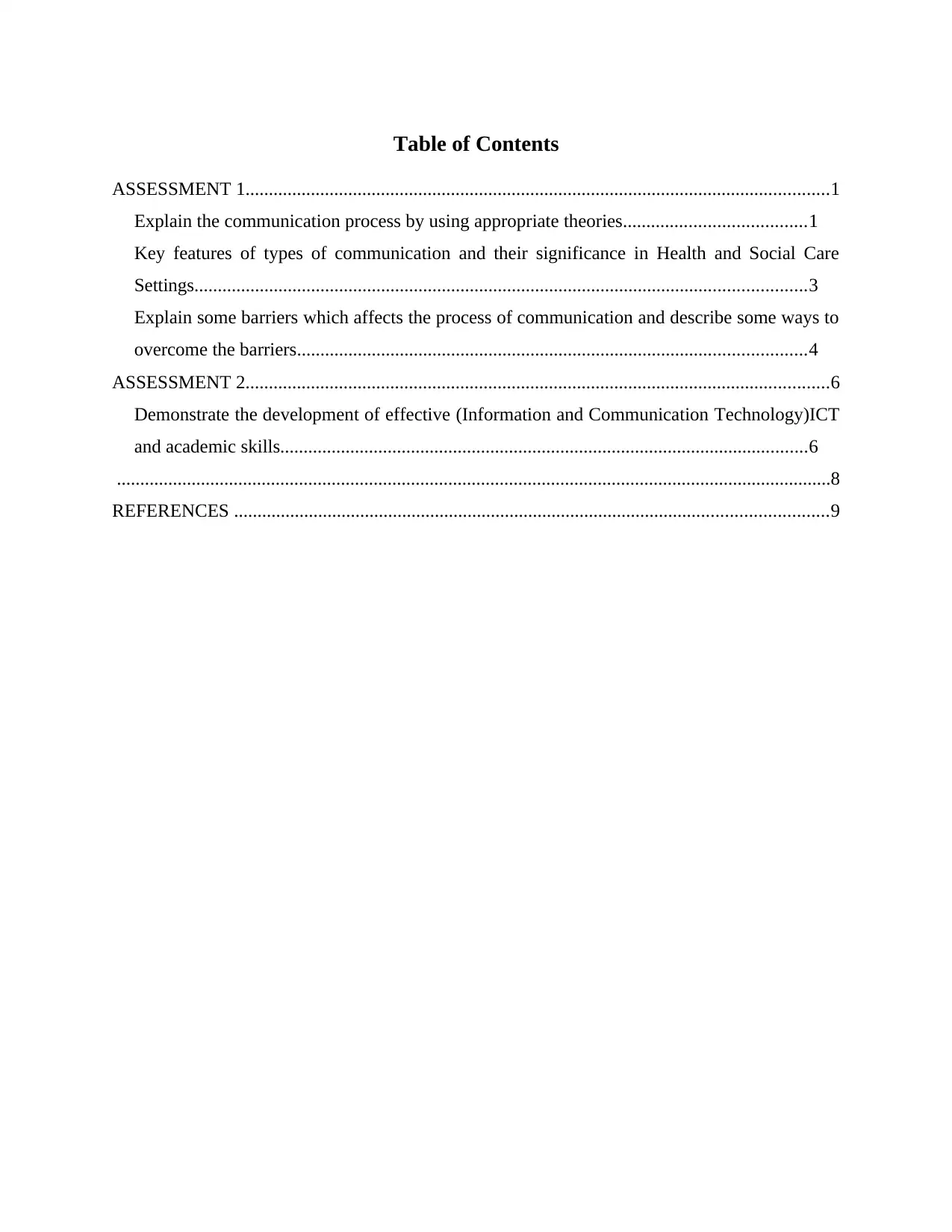
Table of Contents
ASSESSMENT 1.............................................................................................................................1
Explain the communication process by using appropriate theories.......................................1
Key features of types of communication and their significance in Health and Social Care
Settings...................................................................................................................................3
Explain some barriers which affects the process of communication and describe some ways to
overcome the barriers.............................................................................................................4
ASSESSMENT 2.............................................................................................................................6
Demonstrate the development of effective (Information and Communication Technology)ICT
and academic skills.................................................................................................................6
.........................................................................................................................................................8
REFERENCES ...............................................................................................................................9
ASSESSMENT 1.............................................................................................................................1
Explain the communication process by using appropriate theories.......................................1
Key features of types of communication and their significance in Health and Social Care
Settings...................................................................................................................................3
Explain some barriers which affects the process of communication and describe some ways to
overcome the barriers.............................................................................................................4
ASSESSMENT 2.............................................................................................................................6
Demonstrate the development of effective (Information and Communication Technology)ICT
and academic skills.................................................................................................................6
.........................................................................................................................................................8
REFERENCES ...............................................................................................................................9
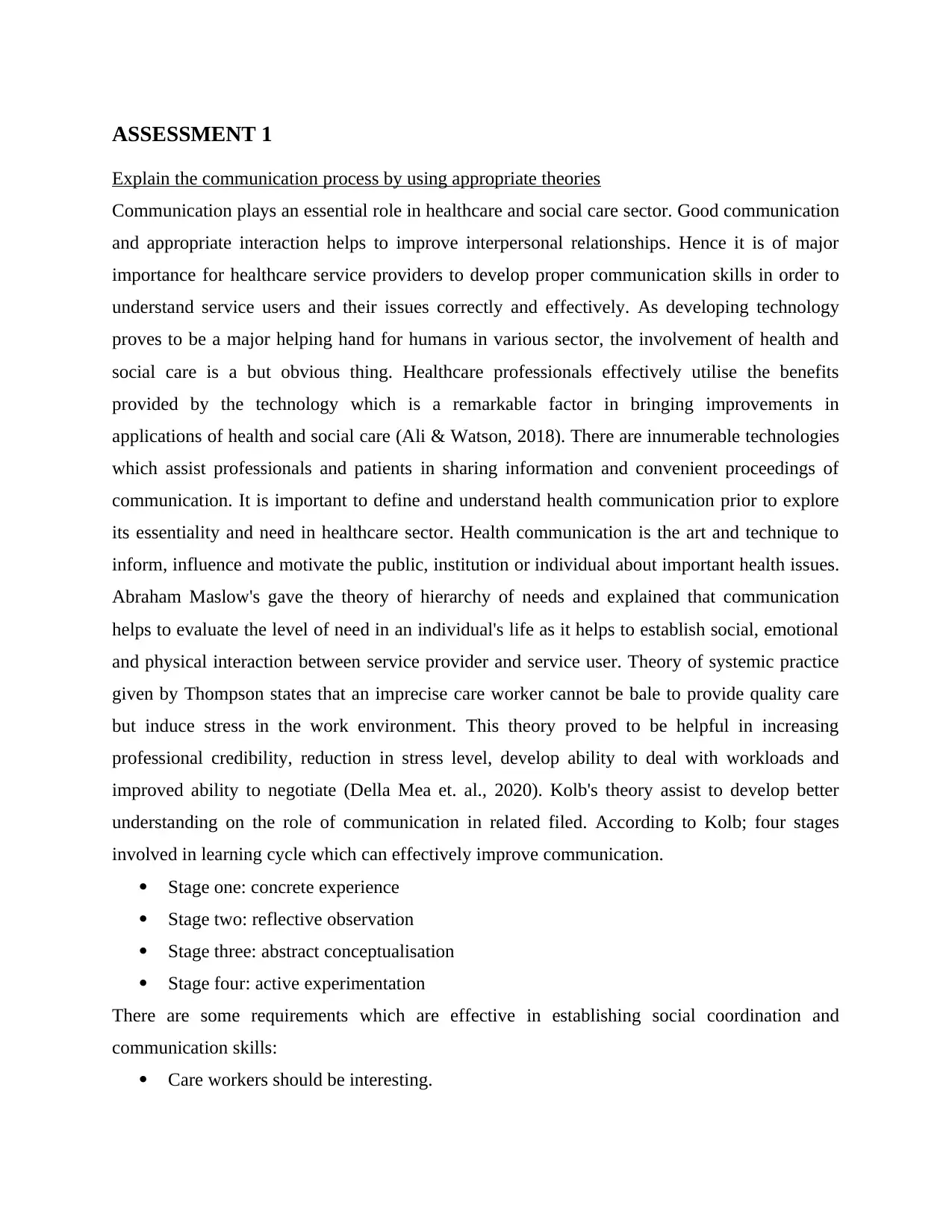
ASSESSMENT 1
Explain the communication process by using appropriate theories
Communication plays an essential role in healthcare and social care sector. Good communication
and appropriate interaction helps to improve interpersonal relationships. Hence it is of major
importance for healthcare service providers to develop proper communication skills in order to
understand service users and their issues correctly and effectively. As developing technology
proves to be a major helping hand for humans in various sector, the involvement of health and
social care is a but obvious thing. Healthcare professionals effectively utilise the benefits
provided by the technology which is a remarkable factor in bringing improvements in
applications of health and social care (Ali & Watson, 2018). There are innumerable technologies
which assist professionals and patients in sharing information and convenient proceedings of
communication. It is important to define and understand health communication prior to explore
its essentiality and need in healthcare sector. Health communication is the art and technique to
inform, influence and motivate the public, institution or individual about important health issues.
Abraham Maslow's gave the theory of hierarchy of needs and explained that communication
helps to evaluate the level of need in an individual's life as it helps to establish social, emotional
and physical interaction between service provider and service user. Theory of systemic practice
given by Thompson states that an imprecise care worker cannot be bale to provide quality care
but induce stress in the work environment. This theory proved to be helpful in increasing
professional credibility, reduction in stress level, develop ability to deal with workloads and
improved ability to negotiate (Della Mea et. al., 2020). Kolb's theory assist to develop better
understanding on the role of communication in related filed. According to Kolb; four stages
involved in learning cycle which can effectively improve communication.
Stage one: concrete experience
Stage two: reflective observation
Stage three: abstract conceptualisation
Stage four: active experimentation
There are some requirements which are effective in establishing social coordination and
communication skills:
Care workers should be interesting.
Explain the communication process by using appropriate theories
Communication plays an essential role in healthcare and social care sector. Good communication
and appropriate interaction helps to improve interpersonal relationships. Hence it is of major
importance for healthcare service providers to develop proper communication skills in order to
understand service users and their issues correctly and effectively. As developing technology
proves to be a major helping hand for humans in various sector, the involvement of health and
social care is a but obvious thing. Healthcare professionals effectively utilise the benefits
provided by the technology which is a remarkable factor in bringing improvements in
applications of health and social care (Ali & Watson, 2018). There are innumerable technologies
which assist professionals and patients in sharing information and convenient proceedings of
communication. It is important to define and understand health communication prior to explore
its essentiality and need in healthcare sector. Health communication is the art and technique to
inform, influence and motivate the public, institution or individual about important health issues.
Abraham Maslow's gave the theory of hierarchy of needs and explained that communication
helps to evaluate the level of need in an individual's life as it helps to establish social, emotional
and physical interaction between service provider and service user. Theory of systemic practice
given by Thompson states that an imprecise care worker cannot be bale to provide quality care
but induce stress in the work environment. This theory proved to be helpful in increasing
professional credibility, reduction in stress level, develop ability to deal with workloads and
improved ability to negotiate (Della Mea et. al., 2020). Kolb's theory assist to develop better
understanding on the role of communication in related filed. According to Kolb; four stages
involved in learning cycle which can effectively improve communication.
Stage one: concrete experience
Stage two: reflective observation
Stage three: abstract conceptualisation
Stage four: active experimentation
There are some requirements which are effective in establishing social coordination and
communication skills:
Care workers should be interesting.
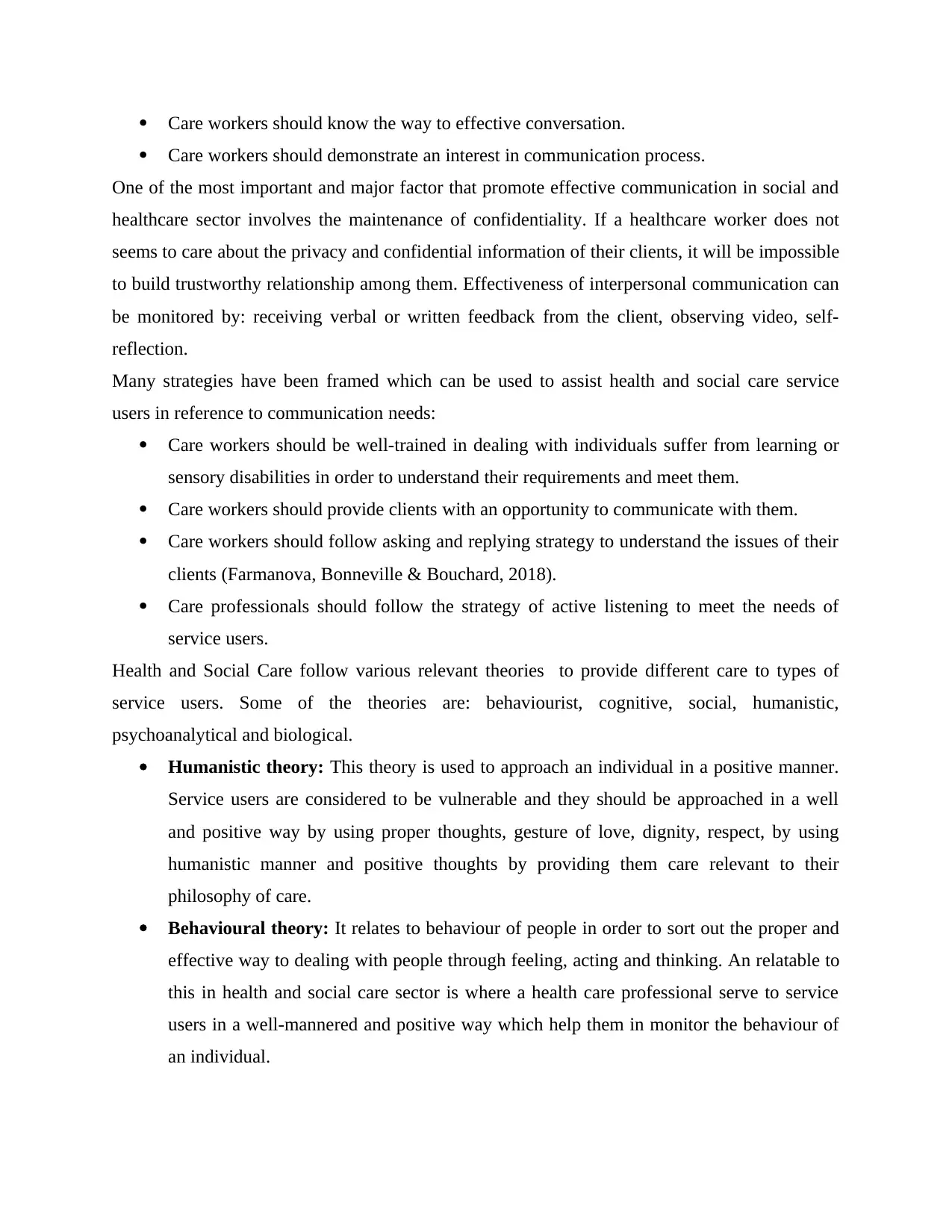
Care workers should know the way to effective conversation.
Care workers should demonstrate an interest in communication process.
One of the most important and major factor that promote effective communication in social and
healthcare sector involves the maintenance of confidentiality. If a healthcare worker does not
seems to care about the privacy and confidential information of their clients, it will be impossible
to build trustworthy relationship among them. Effectiveness of interpersonal communication can
be monitored by: receiving verbal or written feedback from the client, observing video, self-
reflection.
Many strategies have been framed which can be used to assist health and social care service
users in reference to communication needs:
Care workers should be well-trained in dealing with individuals suffer from learning or
sensory disabilities in order to understand their requirements and meet them.
Care workers should provide clients with an opportunity to communicate with them.
Care workers should follow asking and replying strategy to understand the issues of their
clients (Farmanova, Bonneville & Bouchard, 2018).
Care professionals should follow the strategy of active listening to meet the needs of
service users.
Health and Social Care follow various relevant theories to provide different care to types of
service users. Some of the theories are: behaviourist, cognitive, social, humanistic,
psychoanalytical and biological.
Humanistic theory: This theory is used to approach an individual in a positive manner.
Service users are considered to be vulnerable and they should be approached in a well
and positive way by using proper thoughts, gesture of love, dignity, respect, by using
humanistic manner and positive thoughts by providing them care relevant to their
philosophy of care.
Behavioural theory: It relates to behaviour of people in order to sort out the proper and
effective way to dealing with people through feeling, acting and thinking. An relatable to
this in health and social care sector is where a health care professional serve to service
users in a well-mannered and positive way which help them in monitor the behaviour of
an individual.
Care workers should demonstrate an interest in communication process.
One of the most important and major factor that promote effective communication in social and
healthcare sector involves the maintenance of confidentiality. If a healthcare worker does not
seems to care about the privacy and confidential information of their clients, it will be impossible
to build trustworthy relationship among them. Effectiveness of interpersonal communication can
be monitored by: receiving verbal or written feedback from the client, observing video, self-
reflection.
Many strategies have been framed which can be used to assist health and social care service
users in reference to communication needs:
Care workers should be well-trained in dealing with individuals suffer from learning or
sensory disabilities in order to understand their requirements and meet them.
Care workers should provide clients with an opportunity to communicate with them.
Care workers should follow asking and replying strategy to understand the issues of their
clients (Farmanova, Bonneville & Bouchard, 2018).
Care professionals should follow the strategy of active listening to meet the needs of
service users.
Health and Social Care follow various relevant theories to provide different care to types of
service users. Some of the theories are: behaviourist, cognitive, social, humanistic,
psychoanalytical and biological.
Humanistic theory: This theory is used to approach an individual in a positive manner.
Service users are considered to be vulnerable and they should be approached in a well
and positive way by using proper thoughts, gesture of love, dignity, respect, by using
humanistic manner and positive thoughts by providing them care relevant to their
philosophy of care.
Behavioural theory: It relates to behaviour of people in order to sort out the proper and
effective way to dealing with people through feeling, acting and thinking. An relatable to
this in health and social care sector is where a health care professional serve to service
users in a well-mannered and positive way which help them in monitor the behaviour of
an individual.
Secure Best Marks with AI Grader
Need help grading? Try our AI Grader for instant feedback on your assignments.
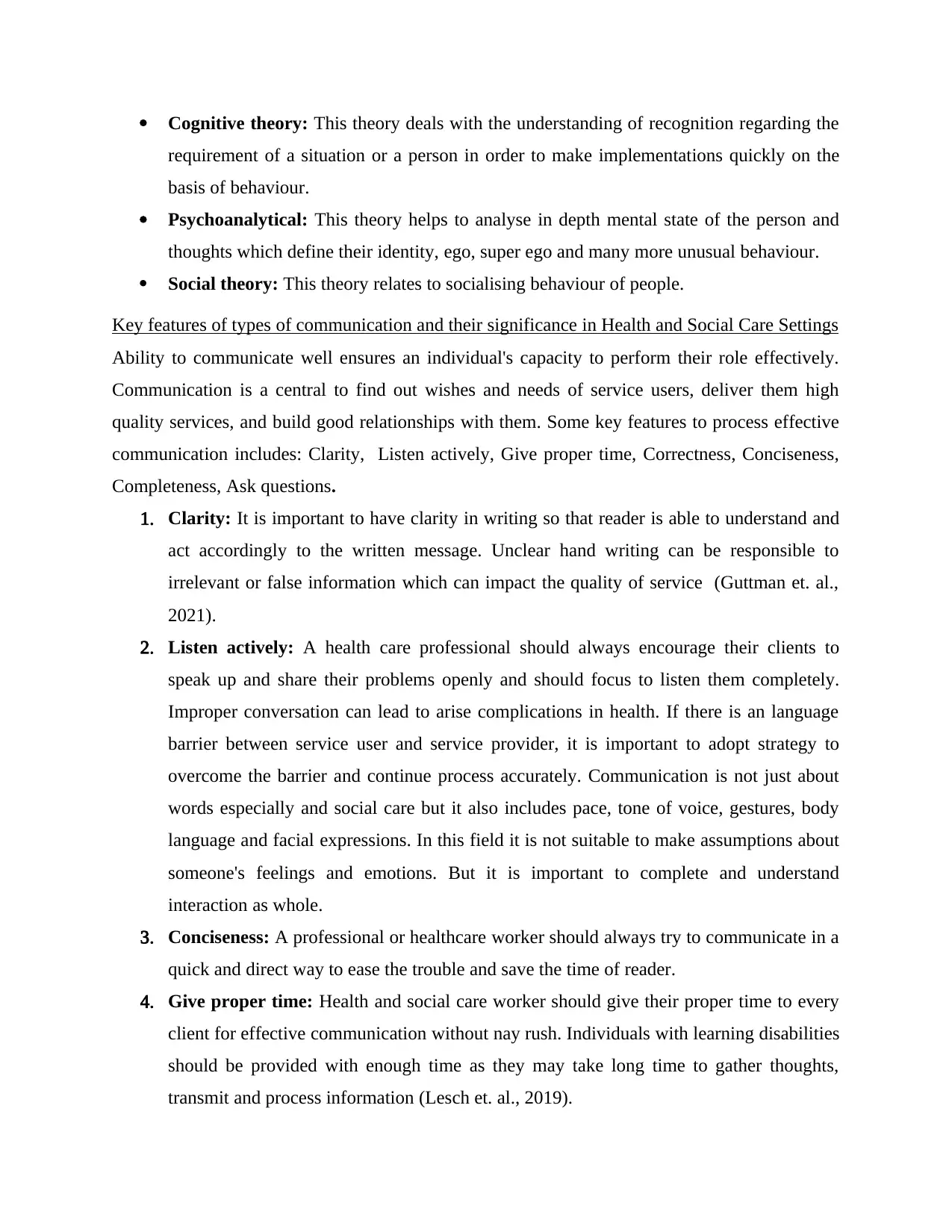
Cognitive theory: This theory deals with the understanding of recognition regarding the
requirement of a situation or a person in order to make implementations quickly on the
basis of behaviour.
Psychoanalytical: This theory helps to analyse in depth mental state of the person and
thoughts which define their identity, ego, super ego and many more unusual behaviour.
Social theory: This theory relates to socialising behaviour of people.
Key features of types of communication and their significance in Health and Social Care Settings
Ability to communicate well ensures an individual's capacity to perform their role effectively.
Communication is a central to find out wishes and needs of service users, deliver them high
quality services, and build good relationships with them. Some key features to process effective
communication includes: Clarity, Listen actively, Give proper time, Correctness, Conciseness,
Completeness, Ask questions.
1. Clarity: It is important to have clarity in writing so that reader is able to understand and
act accordingly to the written message. Unclear hand writing can be responsible to
irrelevant or false information which can impact the quality of service (Guttman et. al.,
2021).
2. Listen actively: A health care professional should always encourage their clients to
speak up and share their problems openly and should focus to listen them completely.
Improper conversation can lead to arise complications in health. If there is an language
barrier between service user and service provider, it is important to adopt strategy to
overcome the barrier and continue process accurately. Communication is not just about
words especially and social care but it also includes pace, tone of voice, gestures, body
language and facial expressions. In this field it is not suitable to make assumptions about
someone's feelings and emotions. But it is important to complete and understand
interaction as whole.
3. Conciseness: A professional or healthcare worker should always try to communicate in a
quick and direct way to ease the trouble and save the time of reader.
4. Give proper time: Health and social care worker should give their proper time to every
client for effective communication without nay rush. Individuals with learning disabilities
should be provided with enough time as they may take long time to gather thoughts,
transmit and process information (Lesch et. al., 2019).
requirement of a situation or a person in order to make implementations quickly on the
basis of behaviour.
Psychoanalytical: This theory helps to analyse in depth mental state of the person and
thoughts which define their identity, ego, super ego and many more unusual behaviour.
Social theory: This theory relates to socialising behaviour of people.
Key features of types of communication and their significance in Health and Social Care Settings
Ability to communicate well ensures an individual's capacity to perform their role effectively.
Communication is a central to find out wishes and needs of service users, deliver them high
quality services, and build good relationships with them. Some key features to process effective
communication includes: Clarity, Listen actively, Give proper time, Correctness, Conciseness,
Completeness, Ask questions.
1. Clarity: It is important to have clarity in writing so that reader is able to understand and
act accordingly to the written message. Unclear hand writing can be responsible to
irrelevant or false information which can impact the quality of service (Guttman et. al.,
2021).
2. Listen actively: A health care professional should always encourage their clients to
speak up and share their problems openly and should focus to listen them completely.
Improper conversation can lead to arise complications in health. If there is an language
barrier between service user and service provider, it is important to adopt strategy to
overcome the barrier and continue process accurately. Communication is not just about
words especially and social care but it also includes pace, tone of voice, gestures, body
language and facial expressions. In this field it is not suitable to make assumptions about
someone's feelings and emotions. But it is important to complete and understand
interaction as whole.
3. Conciseness: A professional or healthcare worker should always try to communicate in a
quick and direct way to ease the trouble and save the time of reader.
4. Give proper time: Health and social care worker should give their proper time to every
client for effective communication without nay rush. Individuals with learning disabilities
should be provided with enough time as they may take long time to gather thoughts,
transmit and process information (Lesch et. al., 2019).
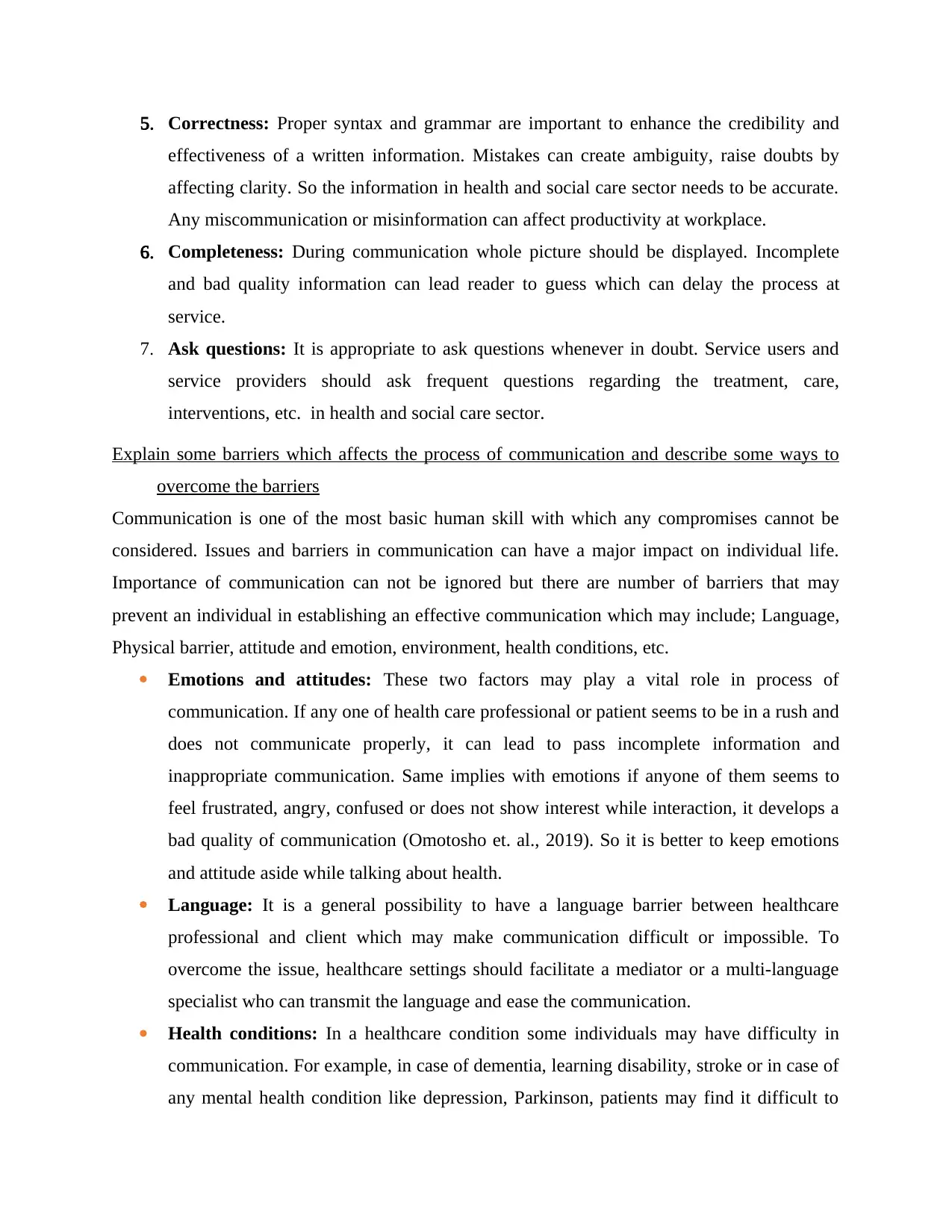
5. Correctness: Proper syntax and grammar are important to enhance the credibility and
effectiveness of a written information. Mistakes can create ambiguity, raise doubts by
affecting clarity. So the information in health and social care sector needs to be accurate.
Any miscommunication or misinformation can affect productivity at workplace.
6. Completeness: During communication whole picture should be displayed. Incomplete
and bad quality information can lead reader to guess which can delay the process at
service.
7. Ask questions: It is appropriate to ask questions whenever in doubt. Service users and
service providers should ask frequent questions regarding the treatment, care,
interventions, etc. in health and social care sector.
Explain some barriers which affects the process of communication and describe some ways to
overcome the barriers
Communication is one of the most basic human skill with which any compromises cannot be
considered. Issues and barriers in communication can have a major impact on individual life.
Importance of communication can not be ignored but there are number of barriers that may
prevent an individual in establishing an effective communication which may include; Language,
Physical barrier, attitude and emotion, environment, health conditions, etc.
Emotions and attitudes: These two factors may play a vital role in process of
communication. If any one of health care professional or patient seems to be in a rush and
does not communicate properly, it can lead to pass incomplete information and
inappropriate communication. Same implies with emotions if anyone of them seems to
feel frustrated, angry, confused or does not show interest while interaction, it develops a
bad quality of communication (Omotosho et. al., 2019). So it is better to keep emotions
and attitude aside while talking about health.
Language: It is a general possibility to have a language barrier between healthcare
professional and client which may make communication difficult or impossible. To
overcome the issue, healthcare settings should facilitate a mediator or a multi-language
specialist who can transmit the language and ease the communication.
Health conditions: In a healthcare condition some individuals may have difficulty in
communication. For example, in case of dementia, learning disability, stroke or in case of
any mental health condition like depression, Parkinson, patients may find it difficult to
effectiveness of a written information. Mistakes can create ambiguity, raise doubts by
affecting clarity. So the information in health and social care sector needs to be accurate.
Any miscommunication or misinformation can affect productivity at workplace.
6. Completeness: During communication whole picture should be displayed. Incomplete
and bad quality information can lead reader to guess which can delay the process at
service.
7. Ask questions: It is appropriate to ask questions whenever in doubt. Service users and
service providers should ask frequent questions regarding the treatment, care,
interventions, etc. in health and social care sector.
Explain some barriers which affects the process of communication and describe some ways to
overcome the barriers
Communication is one of the most basic human skill with which any compromises cannot be
considered. Issues and barriers in communication can have a major impact on individual life.
Importance of communication can not be ignored but there are number of barriers that may
prevent an individual in establishing an effective communication which may include; Language,
Physical barrier, attitude and emotion, environment, health conditions, etc.
Emotions and attitudes: These two factors may play a vital role in process of
communication. If any one of health care professional or patient seems to be in a rush and
does not communicate properly, it can lead to pass incomplete information and
inappropriate communication. Same implies with emotions if anyone of them seems to
feel frustrated, angry, confused or does not show interest while interaction, it develops a
bad quality of communication (Omotosho et. al., 2019). So it is better to keep emotions
and attitude aside while talking about health.
Language: It is a general possibility to have a language barrier between healthcare
professional and client which may make communication difficult or impossible. To
overcome the issue, healthcare settings should facilitate a mediator or a multi-language
specialist who can transmit the language and ease the communication.
Health conditions: In a healthcare condition some individuals may have difficulty in
communication. For example, in case of dementia, learning disability, stroke or in case of
any mental health condition like depression, Parkinson, patients may find it difficult to
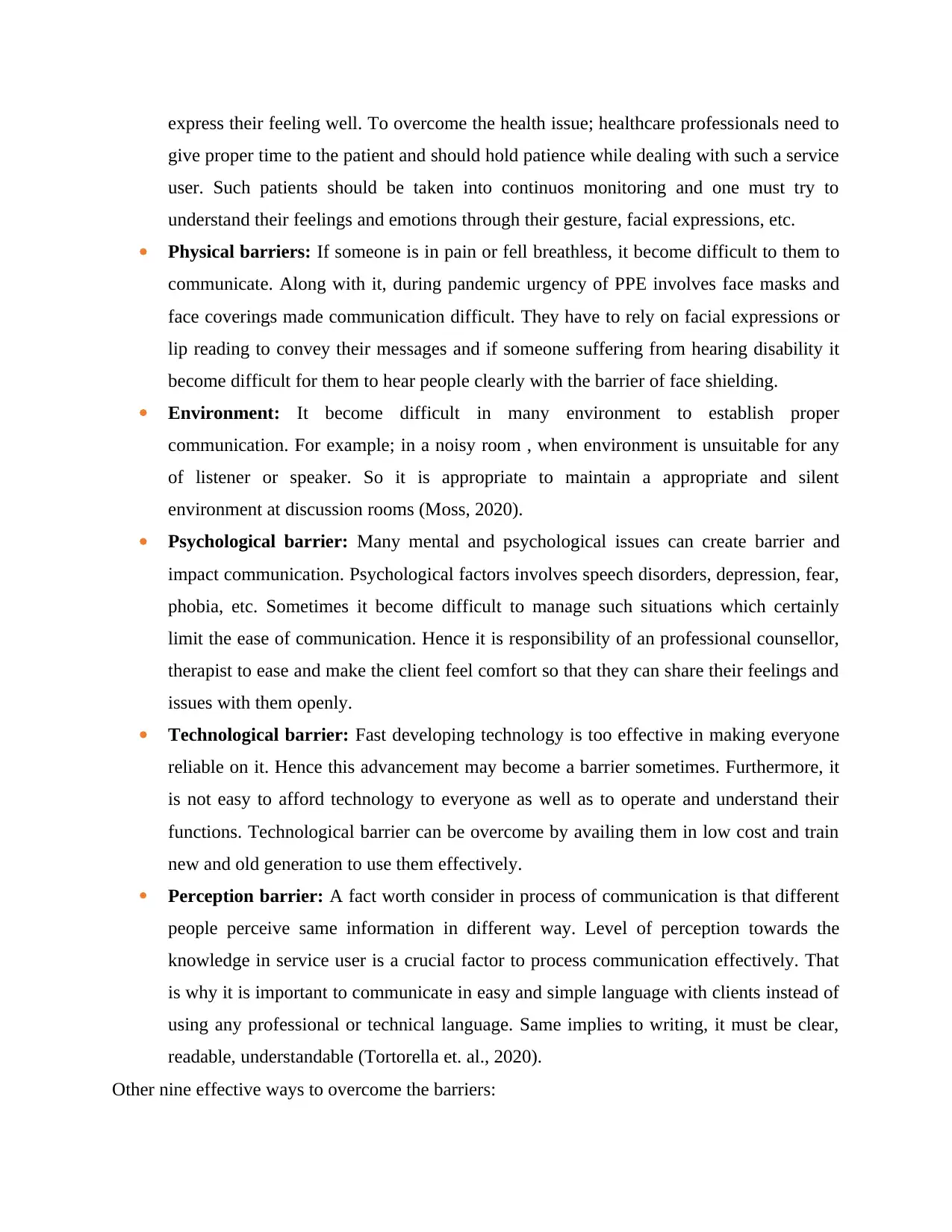
express their feeling well. To overcome the health issue; healthcare professionals need to
give proper time to the patient and should hold patience while dealing with such a service
user. Such patients should be taken into continuos monitoring and one must try to
understand their feelings and emotions through their gesture, facial expressions, etc.
Physical barriers: If someone is in pain or fell breathless, it become difficult to them to
communicate. Along with it, during pandemic urgency of PPE involves face masks and
face coverings made communication difficult. They have to rely on facial expressions or
lip reading to convey their messages and if someone suffering from hearing disability it
become difficult for them to hear people clearly with the barrier of face shielding.
Environment: It become difficult in many environment to establish proper
communication. For example; in a noisy room , when environment is unsuitable for any
of listener or speaker. So it is appropriate to maintain a appropriate and silent
environment at discussion rooms (Moss, 2020).
Psychological barrier: Many mental and psychological issues can create barrier and
impact communication. Psychological factors involves speech disorders, depression, fear,
phobia, etc. Sometimes it become difficult to manage such situations which certainly
limit the ease of communication. Hence it is responsibility of an professional counsellor,
therapist to ease and make the client feel comfort so that they can share their feelings and
issues with them openly.
Technological barrier: Fast developing technology is too effective in making everyone
reliable on it. Hence this advancement may become a barrier sometimes. Furthermore, it
is not easy to afford technology to everyone as well as to operate and understand their
functions. Technological barrier can be overcome by availing them in low cost and train
new and old generation to use them effectively.
Perception barrier: A fact worth consider in process of communication is that different
people perceive same information in different way. Level of perception towards the
knowledge in service user is a crucial factor to process communication effectively. That
is why it is important to communicate in easy and simple language with clients instead of
using any professional or technical language. Same implies to writing, it must be clear,
readable, understandable (Tortorella et. al., 2020).
Other nine effective ways to overcome the barriers:
give proper time to the patient and should hold patience while dealing with such a service
user. Such patients should be taken into continuos monitoring and one must try to
understand their feelings and emotions through their gesture, facial expressions, etc.
Physical barriers: If someone is in pain or fell breathless, it become difficult to them to
communicate. Along with it, during pandemic urgency of PPE involves face masks and
face coverings made communication difficult. They have to rely on facial expressions or
lip reading to convey their messages and if someone suffering from hearing disability it
become difficult for them to hear people clearly with the barrier of face shielding.
Environment: It become difficult in many environment to establish proper
communication. For example; in a noisy room , when environment is unsuitable for any
of listener or speaker. So it is appropriate to maintain a appropriate and silent
environment at discussion rooms (Moss, 2020).
Psychological barrier: Many mental and psychological issues can create barrier and
impact communication. Psychological factors involves speech disorders, depression, fear,
phobia, etc. Sometimes it become difficult to manage such situations which certainly
limit the ease of communication. Hence it is responsibility of an professional counsellor,
therapist to ease and make the client feel comfort so that they can share their feelings and
issues with them openly.
Technological barrier: Fast developing technology is too effective in making everyone
reliable on it. Hence this advancement may become a barrier sometimes. Furthermore, it
is not easy to afford technology to everyone as well as to operate and understand their
functions. Technological barrier can be overcome by availing them in low cost and train
new and old generation to use them effectively.
Perception barrier: A fact worth consider in process of communication is that different
people perceive same information in different way. Level of perception towards the
knowledge in service user is a crucial factor to process communication effectively. That
is why it is important to communicate in easy and simple language with clients instead of
using any professional or technical language. Same implies to writing, it must be clear,
readable, understandable (Tortorella et. al., 2020).
Other nine effective ways to overcome the barriers:
Paraphrase This Document
Need a fresh take? Get an instant paraphrase of this document with our AI Paraphraser
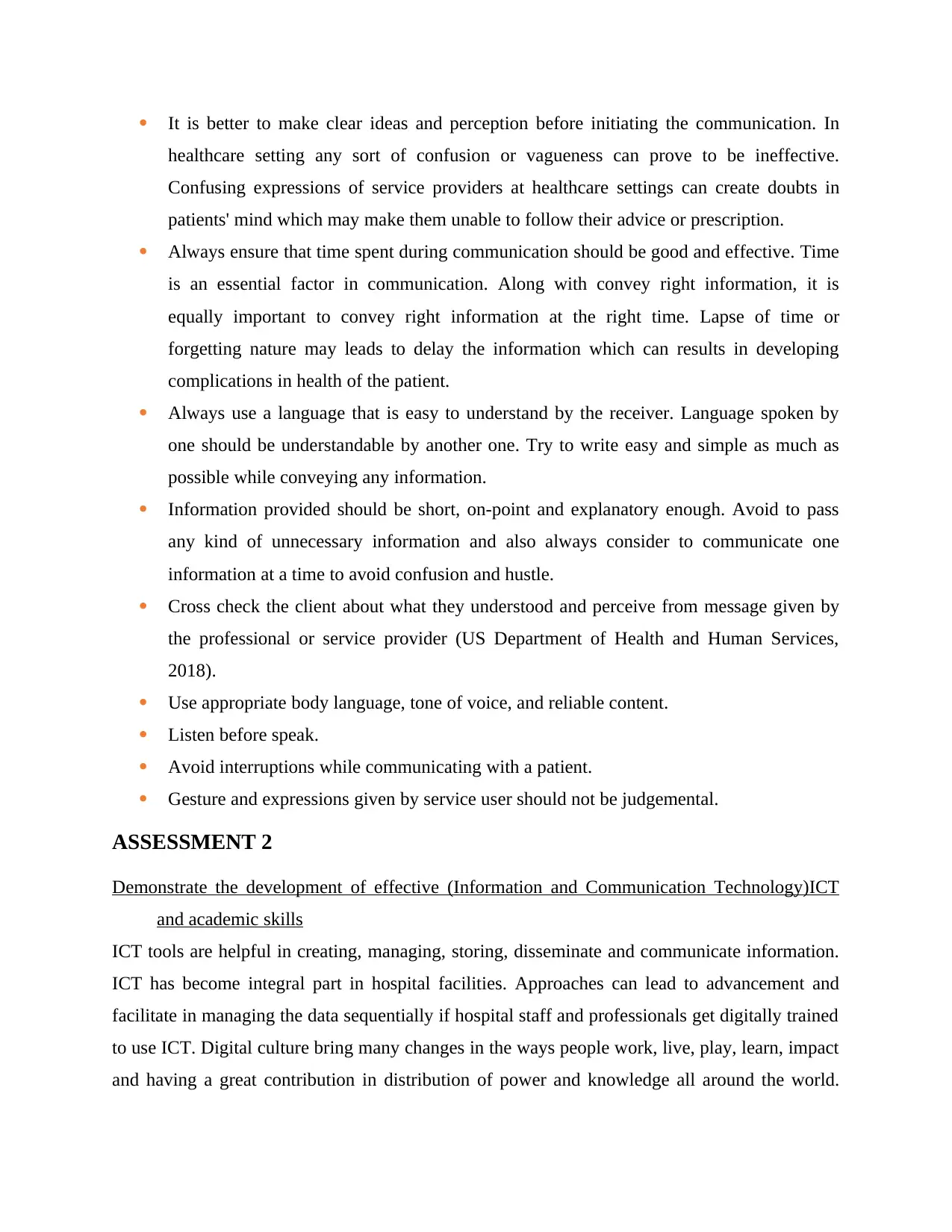
It is better to make clear ideas and perception before initiating the communication. In
healthcare setting any sort of confusion or vagueness can prove to be ineffective.
Confusing expressions of service providers at healthcare settings can create doubts in
patients' mind which may make them unable to follow their advice or prescription.
Always ensure that time spent during communication should be good and effective. Time
is an essential factor in communication. Along with convey right information, it is
equally important to convey right information at the right time. Lapse of time or
forgetting nature may leads to delay the information which can results in developing
complications in health of the patient.
Always use a language that is easy to understand by the receiver. Language spoken by
one should be understandable by another one. Try to write easy and simple as much as
possible while conveying any information.
Information provided should be short, on-point and explanatory enough. Avoid to pass
any kind of unnecessary information and also always consider to communicate one
information at a time to avoid confusion and hustle.
Cross check the client about what they understood and perceive from message given by
the professional or service provider (US Department of Health and Human Services,
2018).
Use appropriate body language, tone of voice, and reliable content.
Listen before speak.
Avoid interruptions while communicating with a patient.
Gesture and expressions given by service user should not be judgemental.
ASSESSMENT 2
Demonstrate the development of effective (Information and Communication Technology)ICT
and academic skills
ICT tools are helpful in creating, managing, storing, disseminate and communicate information.
ICT has become integral part in hospital facilities. Approaches can lead to advancement and
facilitate in managing the data sequentially if hospital staff and professionals get digitally trained
to use ICT. Digital culture bring many changes in the ways people work, live, play, learn, impact
and having a great contribution in distribution of power and knowledge all around the world.
healthcare setting any sort of confusion or vagueness can prove to be ineffective.
Confusing expressions of service providers at healthcare settings can create doubts in
patients' mind which may make them unable to follow their advice or prescription.
Always ensure that time spent during communication should be good and effective. Time
is an essential factor in communication. Along with convey right information, it is
equally important to convey right information at the right time. Lapse of time or
forgetting nature may leads to delay the information which can results in developing
complications in health of the patient.
Always use a language that is easy to understand by the receiver. Language spoken by
one should be understandable by another one. Try to write easy and simple as much as
possible while conveying any information.
Information provided should be short, on-point and explanatory enough. Avoid to pass
any kind of unnecessary information and also always consider to communicate one
information at a time to avoid confusion and hustle.
Cross check the client about what they understood and perceive from message given by
the professional or service provider (US Department of Health and Human Services,
2018).
Use appropriate body language, tone of voice, and reliable content.
Listen before speak.
Avoid interruptions while communicating with a patient.
Gesture and expressions given by service user should not be judgemental.
ASSESSMENT 2
Demonstrate the development of effective (Information and Communication Technology)ICT
and academic skills
ICT tools are helpful in creating, managing, storing, disseminate and communicate information.
ICT has become integral part in hospital facilities. Approaches can lead to advancement and
facilitate in managing the data sequentially if hospital staff and professionals get digitally trained
to use ICT. Digital culture bring many changes in the ways people work, live, play, learn, impact
and having a great contribution in distribution of power and knowledge all around the world.
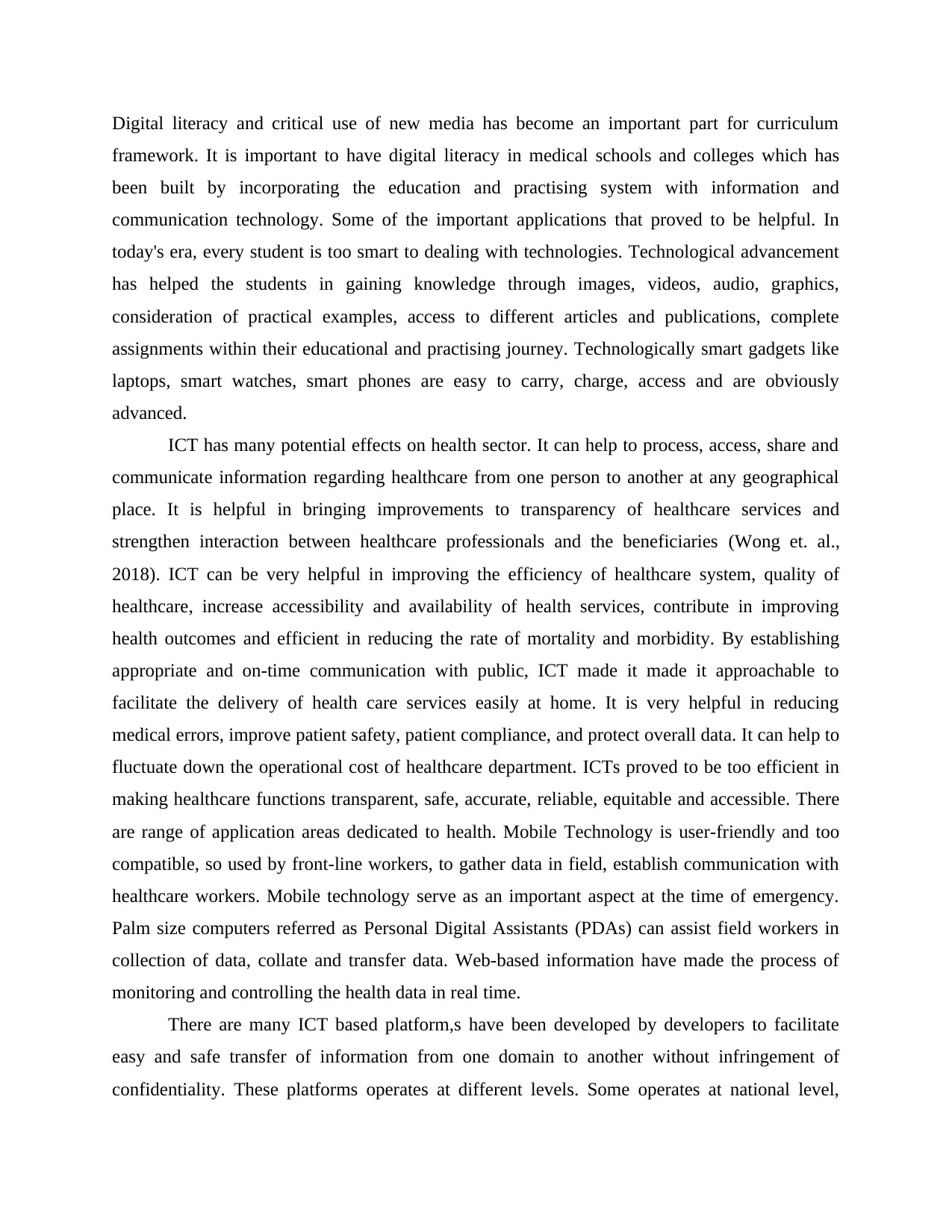
Digital literacy and critical use of new media has become an important part for curriculum
framework. It is important to have digital literacy in medical schools and colleges which has
been built by incorporating the education and practising system with information and
communication technology. Some of the important applications that proved to be helpful. In
today's era, every student is too smart to dealing with technologies. Technological advancement
has helped the students in gaining knowledge through images, videos, audio, graphics,
consideration of practical examples, access to different articles and publications, complete
assignments within their educational and practising journey. Technologically smart gadgets like
laptops, smart watches, smart phones are easy to carry, charge, access and are obviously
advanced.
ICT has many potential effects on health sector. It can help to process, access, share and
communicate information regarding healthcare from one person to another at any geographical
place. It is helpful in bringing improvements to transparency of healthcare services and
strengthen interaction between healthcare professionals and the beneficiaries (Wong et. al.,
2018). ICT can be very helpful in improving the efficiency of healthcare system, quality of
healthcare, increase accessibility and availability of health services, contribute in improving
health outcomes and efficient in reducing the rate of mortality and morbidity. By establishing
appropriate and on-time communication with public, ICT made it made it approachable to
facilitate the delivery of health care services easily at home. It is very helpful in reducing
medical errors, improve patient safety, patient compliance, and protect overall data. It can help to
fluctuate down the operational cost of healthcare department. ICTs proved to be too efficient in
making healthcare functions transparent, safe, accurate, reliable, equitable and accessible. There
are range of application areas dedicated to health. Mobile Technology is user-friendly and too
compatible, so used by front-line workers, to gather data in field, establish communication with
healthcare workers. Mobile technology serve as an important aspect at the time of emergency.
Palm size computers referred as Personal Digital Assistants (PDAs) can assist field workers in
collection of data, collate and transfer data. Web-based information have made the process of
monitoring and controlling the health data in real time.
There are many ICT based platform,s have been developed by developers to facilitate
easy and safe transfer of information from one domain to another without infringement of
confidentiality. These platforms operates at different levels. Some operates at national level,
framework. It is important to have digital literacy in medical schools and colleges which has
been built by incorporating the education and practising system with information and
communication technology. Some of the important applications that proved to be helpful. In
today's era, every student is too smart to dealing with technologies. Technological advancement
has helped the students in gaining knowledge through images, videos, audio, graphics,
consideration of practical examples, access to different articles and publications, complete
assignments within their educational and practising journey. Technologically smart gadgets like
laptops, smart watches, smart phones are easy to carry, charge, access and are obviously
advanced.
ICT has many potential effects on health sector. It can help to process, access, share and
communicate information regarding healthcare from one person to another at any geographical
place. It is helpful in bringing improvements to transparency of healthcare services and
strengthen interaction between healthcare professionals and the beneficiaries (Wong et. al.,
2018). ICT can be very helpful in improving the efficiency of healthcare system, quality of
healthcare, increase accessibility and availability of health services, contribute in improving
health outcomes and efficient in reducing the rate of mortality and morbidity. By establishing
appropriate and on-time communication with public, ICT made it made it approachable to
facilitate the delivery of health care services easily at home. It is very helpful in reducing
medical errors, improve patient safety, patient compliance, and protect overall data. It can help to
fluctuate down the operational cost of healthcare department. ICTs proved to be too efficient in
making healthcare functions transparent, safe, accurate, reliable, equitable and accessible. There
are range of application areas dedicated to health. Mobile Technology is user-friendly and too
compatible, so used by front-line workers, to gather data in field, establish communication with
healthcare workers. Mobile technology serve as an important aspect at the time of emergency.
Palm size computers referred as Personal Digital Assistants (PDAs) can assist field workers in
collection of data, collate and transfer data. Web-based information have made the process of
monitoring and controlling the health data in real time.
There are many ICT based platform,s have been developed by developers to facilitate
easy and safe transfer of information from one domain to another without infringement of
confidentiality. These platforms operates at different levels. Some operates at national level,
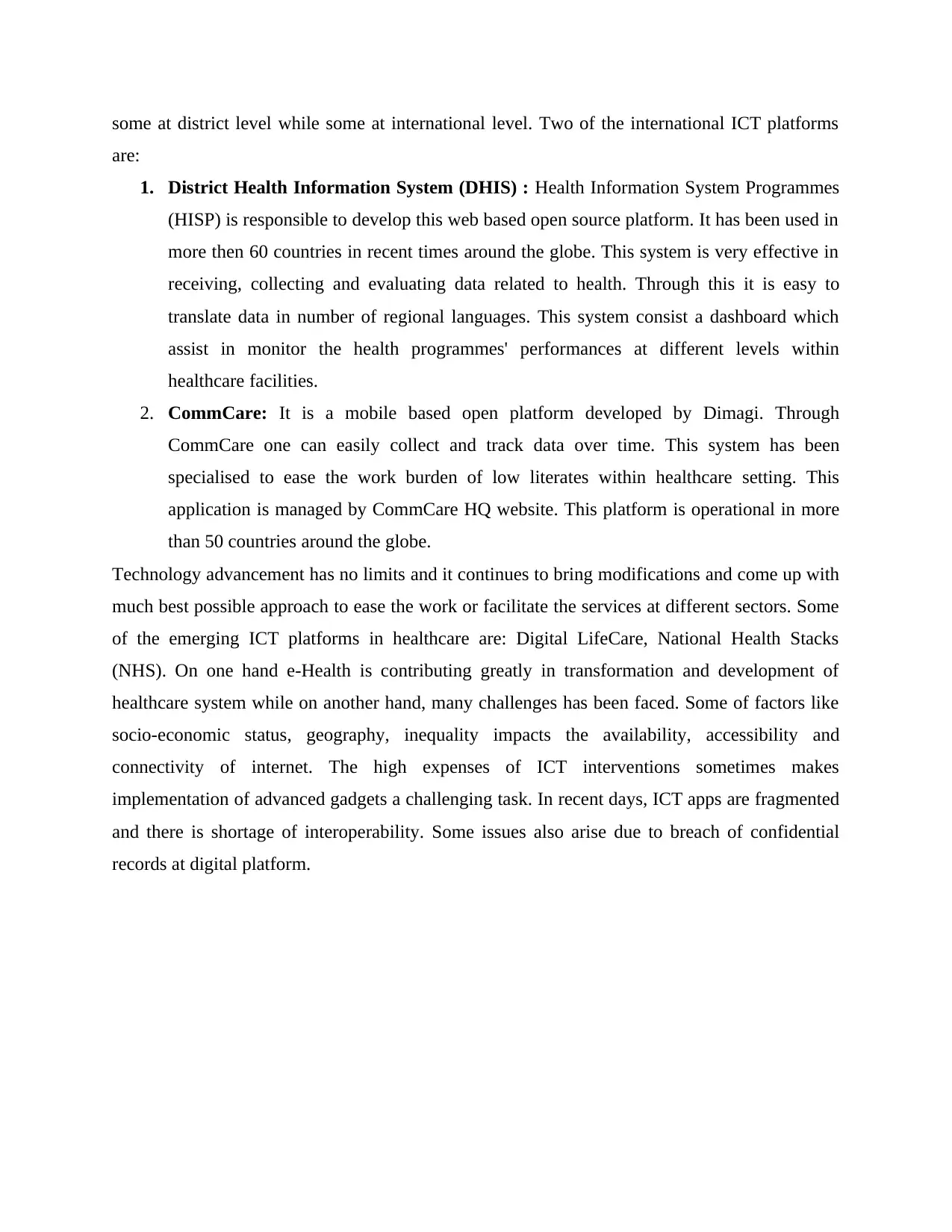
some at district level while some at international level. Two of the international ICT platforms
are:
1. District Health Information System (DHIS) : Health Information System Programmes
(HISP) is responsible to develop this web based open source platform. It has been used in
more then 60 countries in recent times around the globe. This system is very effective in
receiving, collecting and evaluating data related to health. Through this it is easy to
translate data in number of regional languages. This system consist a dashboard which
assist in monitor the health programmes' performances at different levels within
healthcare facilities.
2. CommCare: It is a mobile based open platform developed by Dimagi. Through
CommCare one can easily collect and track data over time. This system has been
specialised to ease the work burden of low literates within healthcare setting. This
application is managed by CommCare HQ website. This platform is operational in more
than 50 countries around the globe.
Technology advancement has no limits and it continues to bring modifications and come up with
much best possible approach to ease the work or facilitate the services at different sectors. Some
of the emerging ICT platforms in healthcare are: Digital LifeCare, National Health Stacks
(NHS). On one hand e-Health is contributing greatly in transformation and development of
healthcare system while on another hand, many challenges has been faced. Some of factors like
socio-economic status, geography, inequality impacts the availability, accessibility and
connectivity of internet. The high expenses of ICT interventions sometimes makes
implementation of advanced gadgets a challenging task. In recent days, ICT apps are fragmented
and there is shortage of interoperability. Some issues also arise due to breach of confidential
records at digital platform.
are:
1. District Health Information System (DHIS) : Health Information System Programmes
(HISP) is responsible to develop this web based open source platform. It has been used in
more then 60 countries in recent times around the globe. This system is very effective in
receiving, collecting and evaluating data related to health. Through this it is easy to
translate data in number of regional languages. This system consist a dashboard which
assist in monitor the health programmes' performances at different levels within
healthcare facilities.
2. CommCare: It is a mobile based open platform developed by Dimagi. Through
CommCare one can easily collect and track data over time. This system has been
specialised to ease the work burden of low literates within healthcare setting. This
application is managed by CommCare HQ website. This platform is operational in more
than 50 countries around the globe.
Technology advancement has no limits and it continues to bring modifications and come up with
much best possible approach to ease the work or facilitate the services at different sectors. Some
of the emerging ICT platforms in healthcare are: Digital LifeCare, National Health Stacks
(NHS). On one hand e-Health is contributing greatly in transformation and development of
healthcare system while on another hand, many challenges has been faced. Some of factors like
socio-economic status, geography, inequality impacts the availability, accessibility and
connectivity of internet. The high expenses of ICT interventions sometimes makes
implementation of advanced gadgets a challenging task. In recent days, ICT apps are fragmented
and there is shortage of interoperability. Some issues also arise due to breach of confidential
records at digital platform.
Secure Best Marks with AI Grader
Need help grading? Try our AI Grader for instant feedback on your assignments.
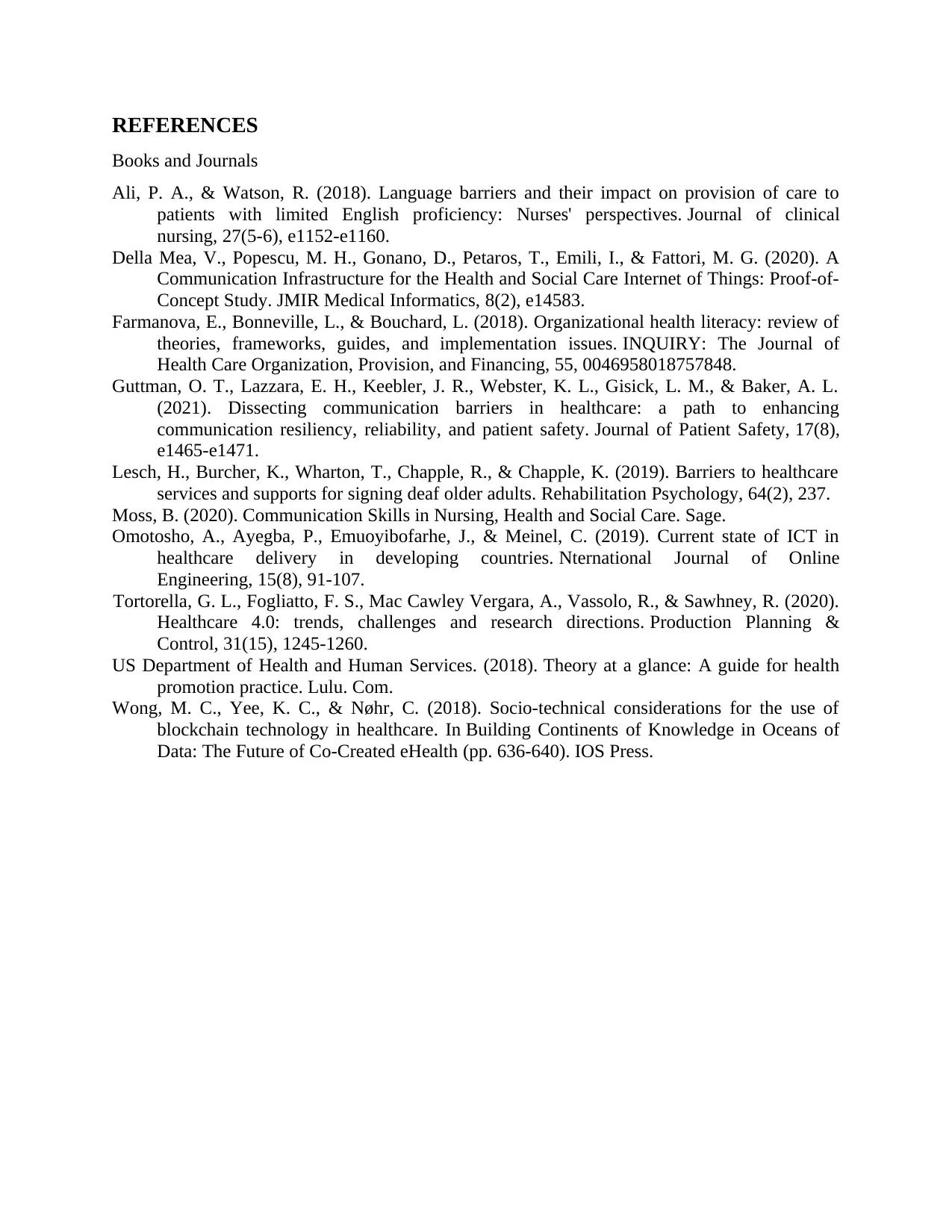
REFERENCES
Books and Journals
Ali, P. A., & Watson, R. (2018). Language barriers and their impact on provision of care to
patients with limited English proficiency: Nurses' perspectives. Journal of clinical
nursing, 27(5-6), e1152-e1160.
Della Mea, V., Popescu, M. H., Gonano, D., Petaros, T., Emili, I., & Fattori, M. G. (2020). A
Communication Infrastructure for the Health and Social Care Internet of Things: Proof-of-
Concept Study. JMIR Medical Informatics, 8(2), e14583.
Farmanova, E., Bonneville, L., & Bouchard, L. (2018). Organizational health literacy: review of
theories, frameworks, guides, and implementation issues. INQUIRY: The Journal of
Health Care Organization, Provision, and Financing, 55, 0046958018757848.
Guttman, O. T., Lazzara, E. H., Keebler, J. R., Webster, K. L., Gisick, L. M., & Baker, A. L.
(2021). Dissecting communication barriers in healthcare: a path to enhancing
communication resiliency, reliability, and patient safety. Journal of Patient Safety, 17(8),
e1465-e1471.
Lesch, H., Burcher, K., Wharton, T., Chapple, R., & Chapple, K. (2019). Barriers to healthcare
services and supports for signing deaf older adults. Rehabilitation Psychology, 64(2), 237.
Moss, B. (2020). Communication Skills in Nursing, Health and Social Care. Sage.
Omotosho, A., Ayegba, P., Emuoyibofarhe, J., & Meinel, C. (2019). Current state of ICT in
healthcare delivery in developing countries. Nternational Journal of Online
Engineering, 15(8), 91-107.
Tortorella, G. L., Fogliatto, F. S., Mac Cawley Vergara, A., Vassolo, R., & Sawhney, R. (2020).
Healthcare 4.0: trends, challenges and research directions. Production Planning &
Control, 31(15), 1245-1260.
US Department of Health and Human Services. (2018). Theory at a glance: A guide for health
promotion practice. Lulu. Com.
Wong, M. C., Yee, K. C., & Nøhr, C. (2018). Socio-technical considerations for the use of
blockchain technology in healthcare. In Building Continents of Knowledge in Oceans of
Data: The Future of Co-Created eHealth (pp. 636-640). IOS Press.
Books and Journals
Ali, P. A., & Watson, R. (2018). Language barriers and their impact on provision of care to
patients with limited English proficiency: Nurses' perspectives. Journal of clinical
nursing, 27(5-6), e1152-e1160.
Della Mea, V., Popescu, M. H., Gonano, D., Petaros, T., Emili, I., & Fattori, M. G. (2020). A
Communication Infrastructure for the Health and Social Care Internet of Things: Proof-of-
Concept Study. JMIR Medical Informatics, 8(2), e14583.
Farmanova, E., Bonneville, L., & Bouchard, L. (2018). Organizational health literacy: review of
theories, frameworks, guides, and implementation issues. INQUIRY: The Journal of
Health Care Organization, Provision, and Financing, 55, 0046958018757848.
Guttman, O. T., Lazzara, E. H., Keebler, J. R., Webster, K. L., Gisick, L. M., & Baker, A. L.
(2021). Dissecting communication barriers in healthcare: a path to enhancing
communication resiliency, reliability, and patient safety. Journal of Patient Safety, 17(8),
e1465-e1471.
Lesch, H., Burcher, K., Wharton, T., Chapple, R., & Chapple, K. (2019). Barriers to healthcare
services and supports for signing deaf older adults. Rehabilitation Psychology, 64(2), 237.
Moss, B. (2020). Communication Skills in Nursing, Health and Social Care. Sage.
Omotosho, A., Ayegba, P., Emuoyibofarhe, J., & Meinel, C. (2019). Current state of ICT in
healthcare delivery in developing countries. Nternational Journal of Online
Engineering, 15(8), 91-107.
Tortorella, G. L., Fogliatto, F. S., Mac Cawley Vergara, A., Vassolo, R., & Sawhney, R. (2020).
Healthcare 4.0: trends, challenges and research directions. Production Planning &
Control, 31(15), 1245-1260.
US Department of Health and Human Services. (2018). Theory at a glance: A guide for health
promotion practice. Lulu. Com.
Wong, M. C., Yee, K. C., & Nøhr, C. (2018). Socio-technical considerations for the use of
blockchain technology in healthcare. In Building Continents of Knowledge in Oceans of
Data: The Future of Co-Created eHealth (pp. 636-640). IOS Press.

1 out of 12
Related Documents
Your All-in-One AI-Powered Toolkit for Academic Success.
+13062052269
info@desklib.com
Available 24*7 on WhatsApp / Email
![[object Object]](/_next/static/media/star-bottom.7253800d.svg)
Unlock your academic potential
© 2024 | Zucol Services PVT LTD | All rights reserved.





